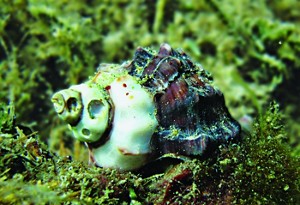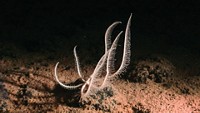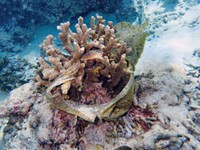Advertisement
Grab your lab coat. Let's get started
Welcome!
Welcome!
Create an account below to get 6 C&EN articles per month, receive newsletters and more - all free.
It seems this is your first time logging in online. Please enter the following information to continue.
As an ACS member you automatically get access to this site. All we need is few more details to create your reading experience.
Not you? Sign in with a different account.
Not you? Sign in with a different account.
ERROR 1
ERROR 1
ERROR 2
ERROR 2
ERROR 2
ERROR 2
ERROR 2
Password and Confirm password must match.
If you have an ACS member number, please enter it here so we can link this account to your membership. (optional)
ERROR 2
ACS values your privacy. By submitting your information, you are gaining access to C&EN and subscribing to our weekly newsletter. We use the information you provide to make your reading experience better, and we will never sell your data to third party members.
Environment
The Mediterranean: Beneath The Surface
The famous sea faces challenges from climate change, pollution, overfishing, and tourism—to name just a few
by Sarah Everts
April 9, 2012
| A version of this story appeared in
Volume 90, Issue 15

The Mediterranean Sea has long been a cauldron of Western civilization: ancient Greek, Roman, Egyptian, and Moorish empires surfaced around it, as did the Renaissance. This relatively small sea is not just historically important, it is also environmentally unique. Containing only 1% of Earth’s vast ocean water, the Mediterranean Sea hosts 8% of the world’s biodiversity, which is currently under threat.
The Mediterranean’s spectacular environment and cultural heritage help draw more than 200 million tourists annually to the region, outnumbering the 150 million people who live in 22 nations around the Mediterranean’s perimeter. In addition, up to one-third of the world’s shipping traffic traverses its waters.
According to the United Nations Environment Programme, some 2,000 vessels weighing more than 100 metric tons each are in the Mediterranean at any given time. The sea is also burdened by overfishing, unregulated tourism, aquaculture, and oil-drilling platforms. Some 200 chemical, petrochemical, and energy plants are found along the coastline.
All this human pressure on the sea does not come without consequences. Environmental groups have been reporting massive die-offs of marine creatures, such as sea turtles, monk seals, and Atlantic tuna—which spawn only in the Mediterranean—as well as coral ecosystems. Ocean acidification due to rising levels of atmospheric carbon dioxide is “adding to the mix of stressors in the Mediterranean and pushing everything in the wrong direction,” says Jason M. Hall-Spencer, a marine biologist at Plymouth University, in England.
Mediterranean country stakeholders have been meeting for several decades to discuss shared environmental problems, but getting concerted action to solve these problems is a challenge, given the 22 nations’ political, economic, linguistic, and cultural differences. And with the Arab Spring and Europe’s economic crisis, the environmental problems threatening the sea have been sidelined by policymakers.
Some 100 million years ago, the Mediterranean Sea began to form along with the Alps as Eurasian and African tectonic plates collided, says Patrizia Ziveri, a paleooceanographer at the Autonomous University of Barcelona.
One of the curious features of the Mediterranean is that it is an extremely isolated ocean, Ziveri says. The only major water exchange with an open ocean occurs with the Atlantic through the narrow Strait of Gibraltar. Other smaller channels, such as the man-made Suez Canal and Turkish Straits connect the Mediterranean with the Red Sea and the Black Sea, respectively. These major shipping routes are also conduits for invasive alien species, such as jellyfish and algae, Hall-Spencer says.
Another defining feature of the Mediterranean is that it is comparatively nutrient-poor yet still manages to support impressive biodiversity. Mediterranean organisms “do not have the luxury of being well fed like those in the North Atlantic,” Hall-Spencer says. Furthermore, the sea goes from nutrient-poor in the west to nutrient-impoverished in the east, says Carol Turley, a biogeochemist at Plymouth’s Marine Laboratory.
In the Mediterranean’s nutrient-destitute eastern waters, nitrogen, carbon, and phosphorus get recycled immediately by phytoplankton and bacteria, which are quickly gobbled up by organisms higher on the food chain. “It’s fascinating that life still manages there even when there are hardly any detectable nutrients,” Turley says.
And because the Mediterranean is so isolated from the open ocean, it becomes warmer and saltier from west to east, where water evaporation happens faster than renewal from the open ocean or from precipitation, Ziveri says. The warmer eastern sea may be a boon to beach-bound tourists; however, climate-change-induced warming in the Mediterranean Sea in this century may exceed that of other oceans, Ziveri adds.
Ziveri is coordinating an $8 million project called MedSeA (Mediterranean Sea acidification in a changing climate) that was started last year to investigate the combined impacts of climate change and ocean acidification on the Mediterranean.
“For the past 25 million years, the surface of the Mediterranean had an average pH of 8.2,” Hall-Spencer says. With the Industrial Revolution and the increased release of CO2, oceans began absorbing a third of the greenhouse gas being pumped into the atmosphere. The Mediterranean’s pH has now dropped to 8.1, Hall-Spencer says. “That means we’ve already increased the number of protons in the Mediterranean by 30%. That’s a huge jump in the corrosiveness of the water, a situation that is getting rapidly worse.”

A fall in Mediterranean pH has major impacts on organisms that use calcium carbonate in their shells or corals. That’s because acidification—due to dissolved CO2 forming carbonic acid—throws normal ocean chemistry out of balance, resulting in corrosion of calcium carbonate from shelled organisms.
In practice, this means that an organism’s shell will dissolve unless the organism can ramp up shell construction to counteract the loss. “If the organism is willing to put a huge amount of energy into shell production because it has tons and tons of food, then perhaps the organism can continue to exist,” Turley says. But the Mediterranean doesn’t provide this bounty of food and is not likely to do so in the future.
Furthermore, “if the organism is working harder chemically to produce shells, then things like reproduction, growth, or defense suffer,” Hall-Spencer adds. “It’s like when humans climb up a mountain. We start to pant for oxygen. We’re working physiologically harder to keep ourselves alive at altitude because it’s difficult to get the oxygen into our bodies,” he explains. “It’s the same for these organisms that haven’t got carbonate in the water that they desperately need to build their skeletons and shells.”
To study how Mediterranean organisms fare at different pH levels, Hall-Spencer and other scientists make use of underwater volcanoes around Italy and Greece where CO2 bubbles up from the seabed in shallow regions of the sea. Tourists call it champagne water, but researchers see it as an effervescent time machine.
That’s because the gradient of CO2 emanating from the seabed alters ocean chemistry, providing a corresponding gradient of acidified environments with pH ranging from 7.3 to 8.1 at different distances from the vents. Researchers have been tabulating what organisms survive at different decreasing pH values, and the results are not comforting (Nature, DOI: 10.1038/nature07051).
For example, Stanford University’s Kristy J. Kroeker and a team of researchers discovered an overall loss of biodiversity, biomass, and food web complexity in acidified regions around these Mediterranean CO2 vents (Proc. Natl. Acad. Sci. USA, DOI: 10.1073/pnas.1107789108). “These results suggest that a loss of biodiversity and ecosystem function is expected under extreme acidification scenarios,” note the authors.
When he swims through a Jacuzzi of CO2-rich water near vents to do experiments, Hall-Spencer says he regularly gets stung by invasive species and jellyfish, which thrive in that environment. “But the corals that we transplant into the areas dissolve away,” he says. “So corals die, but invasive species survive.”
Not all endemic species die in acidified oceans, however. “What keeps me from crying into my cornflakes in the morning is the fact there are some organisms that are clearly very robust,” Hall-Spencer says. “Some of them can survive what we are doing to the chemistry of the oceans. Sea grasses, for example, which can provide nursery areas for juvenile fish, bloom in [acidified] regions around Mediterranean CO2 vents.”
But even acid-tolerant species aren’t performing well, Hall-Spencer says. His team recently discovered that a sea grass called Cymodocea nodosa growing near the vents produces decreased levels of phenolic defense molecules such as proanthocyanidins, hydrozybenzoates, and hydroxycinnamates, making them more vulnerable to hungry fish. “The loss of phenolic substances may explain the higher-than-usual rates of grazing observed near undersea CO2 vents,” Hall-Spencer says. “Our observations temper recent predictions that sea grasses would be winners in a high-CO2 world.”
Aside from the biodiversity loss, Ziveri says, various Mediterranean industries can be affected adversely by acidification, such as the aquaculture of shellfish, which may see a reduction in body mass as the organisms devote more energy to maintaining their shells. The red coral jewelry industry and coral-inspired tourism are likely to suffer too, she says.

Climate-change-related acidification in the Mediterranean is just a worrisome newcomer on a long list of environmental concerns. Scientists and environmental organizations have long been sounding the alarm about other stressors in the sea.
For example, the Mediterranean’s enclosure means that what gets dumped in the sea tends to stay there. Since the Industrial Revolution, the sea “has unfortunately acted as a concentration basin for heavy metals and other pollutants,” such as polychlorinated biphenyls, Ziveri says. A major oil spill like the Deepwater Horizon would be a disaster, she adds, because of limited water exchange with the Atlantic.
Until the 1970s, little was done to control pollution in the Mediterranean. In 1975, the then recently formed United Nations Environment Programme chose the Mediterranean Sea to be the focus of its first marine program, called the Mediterranean Action Plan. In 1976, several Mediterranean countries adopted the Barcelona Convention for the Protection of the Mediterranean Sea Against Pollution.
Neither of these programs led to a legally binding Mediterranean-wide environmental policy. However, they did bring together countries bordering the Mediterranean to discuss pollution problems in the sea, set environmental targets, and establish a Mediterranean pollution-monitoring database to which countries voluntarily contribute data, says Giuseppe Di Carlo, a Mediterranean marine expert with the World Wide Fund for Nature (WWF) Mediterranean Programme Office, in Rome.
Since the programs were established, bureaucrats have penned a cornucopia of international protocols, statements, conventions, and treaties—probably more than needed, says Di Carlo—related to Mediterranean biodiversity, pollution, and fishing. Some are legally binding, but many are not.
Getting legally binding environmental policies for the whole Mediterranean continues to be difficult, Di Carlo says. The region’s 22 nations have vastly different political orientations: the European Union countries (including France, Greece, Italy, and Spain), countries trying to join the EU (such as Albania, Croatia, Montenegro, and Turkey), countries recently in political turmoil (such as Algeria, Egypt, Libya, and Tunisia), as well as countries regarded as political foes by others in the Mediterranean region (such as Cyprus and Israel).
Starting in the 1980s and ’90s, the European Commission began creating legally binding environmental policy for countries in its union, says Damià Barceló, director of the Catalan Institute for Water Research, in Girona, Spain. These were primarily regulations against dumping raw sewage in the Mediterranean and its freshwater sources.
“Polluting discharges in the northern part of the Mediterranean are much less now,” Barceló says, noting that it’s now safe to swim at Barcelona’s city beach, an unthinkable activity in the 1970s.
“In southern Mediterranean countries, the water regulation is not as strict as in Europe, and there are still problems” that are being compounded by the instability brought about by the Arab Spring, he says. For example, Barceló points to the Nile River, a major source of freshwater into the Mediterranean. Damming and heavy-industry sewage dumping has been unregulated in that river, he says.

One of the most active North African countries in water treatment is Morocco, Barceló says. Most major Moroccan cities along the Mediterranean coast have water treatment plants, says Redouane Choukr-Allah, who studies water resource management at the Hassan II Agronomy & Veterinary Institute, in Morocco. However, infrastructure that works for EU countries isn’t always sustainable for Morocco. “We have to look for solutions for treating water that don’t require trained personnel or expensive high-tech equipment,” he says. Morocco has opted to use the country’s abundant sunlight and sand filters to decontaminate sewage prior to releasing it into the Mediterranean.
Pollution is just one of many longtime stressors of the Mediterranean. Although the EU established new legally binding marine policy in 2008 to better monitor biodiversity, fisheries, urban development, and alien species and to implement sustainable growth around the Mediterranean, there’s still room for improvement, Di Carlo says.
WWF estimates that illegal, unregulated, and unreported (IUU) fishing is commonplace in the sea, particularly in Libyan and Italian waters. For example, according to WWF, more than twice the allowable amount of bluefin tuna is being removed from Mediterranean waters annually, which is problematic because bluefin populations have been dropping rapidly. “Currently, the International Commission for the Conservation of Atlantic Tunas is investigating potential IUU activity of EU vessels within Libyan waters conducted last year during the conflict” in Libya, Di Carlo says. He adds that IUU fishing also results in bycatch of endangered marine animals such as turtles and dolphins. “There are some regions in the eastern Mediterranean that are almost barren,” Ziveri says. “You hardly find anything.”
Advertisement
Another problem, says Ziveri, is a dearth of marine protected areas. Only 4% of the Mediterranean is officially protected, primarily in EU country waters. Some of these marine protected areas, such as the Pelagos Sanctuary, which straddles Italy, Monaco, and France, “are underfunded and understaffed,” Di Carlo says. “They are declared, there’s a nice map on paper, but really there’s not much happening on the ground due to a lack of political commitment.” WWF is lobbying the EU to expand protection to 10% of its Mediterranean waters—to reach new targets set at the 2010 Convention on Biological Diversity. WWF is also trying to help non-EU countries, such as Croatia, Lebanon, Libya, and Montenegro, create marine protected areas, Di Carlo says.
Creating more marine protected areas in the Mediterranean is a good short-term solution to reduce adverse impacts from fishing, shipping, and tourism on its biodiversity hot spots, Ziveri says. “Of course, for warming and acidification, the only solution is to reduce global CO2 emissions,” she adds.
“Many of the Mediterranean’s major stressors are global or international issues,” Plymouth’s Turley says. “It is already more vulnerable because it’s a semi-enclosed sea. And with all of its sociopolitical complexity, [one wonders] how the Mediterranean will be able to meet these grand environmental challenges,” Turley adds. “I mean, scientists can say, ‘Look, such and such is happening.’ But the actions are actually carried out by policymakers, governments, and the public.”
For a region that produced such historically important civilizations, perhaps its peoples can eventually rally together to foster a new culture that keeps the Mediterranean Sea healthy and productive for generations to come.






Join the conversation
Contact the reporter
Submit a Letter to the Editor for publication
Engage with us on Twitter